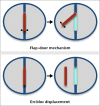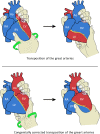Systematic Approach to Malalignment Type Ventricular Septal Defects
- PMID: 33170057
- PMCID: PMC7763733
- DOI: 10.1161/JAHA.120.018275
Systematic Approach to Malalignment Type Ventricular Septal Defects
Abstract
Various congenital heart diseases are associated with malalignment of a part of the ventricular septum. Most commonly, the outlet septum is malaligned toward the right or left ventricle. Less commonly, the whole or a major part of the ventricular septum is malaligned in relation to the atrial septal plane. Although the pathological conditions associated with ventricular septal malalignment have been well recognized, the descriptions are often confusing and sometimes incorrect. In this pictorial essay, we introduce our systematic approach to the assessment of malalignment type ventricular septal defects with typical case examples. The systematic approach comprises description of the essential features of malalignment, including the following: (1) the malaligned part of the ventricular septum, (2) the reference structure, (3) the mechanism of malalignment, (4) the direction of malalignment, and (5) the severity of malalignment.
Keywords: double outlet right ventricle; malalignment; overriding; straddling; ventricular septal defect.
Conflict of interest statement
None.
Figures







References
-
- Anderson RH, Wilcox BR. The surgical anatomy of ventricular septal defects associated with overriding valvar orifices. J Card Surg. 1993;8:130–142. - PubMed
-
- Crucean A, Brawn WJ, Spicer DE, Franklin RC, Anderson RH. Holes and channels between the ventricles revisited. Cardiol Young. 2016;25:1099–1110. - PubMed
-
- Bharati S, McAllister HA Jr, Lev M. Straddling and displaced atrioventricular orifices and valves. Circulation. 1979;60:673–684. - PubMed
-
- Milo S, Ho SY, Macartney FJ, Wilkinson JL, Becker AE, Wenink AC, Gittenberger de Groot AC, Anderson RH. Straddling and overriding atrioventricular valves: morphology and classification. Am J Cardiol. 1979;44:1122–1134. - PubMed
Publication types
MeSH terms
LinkOut - more resources
Full Text Sources

